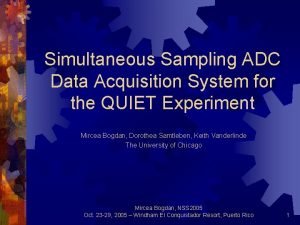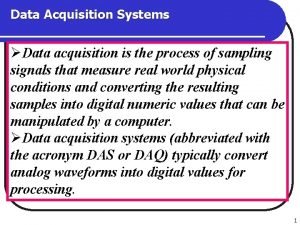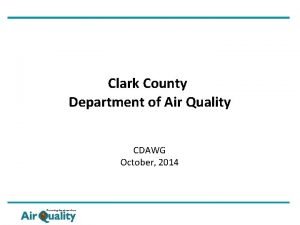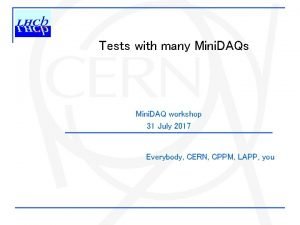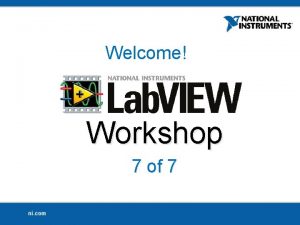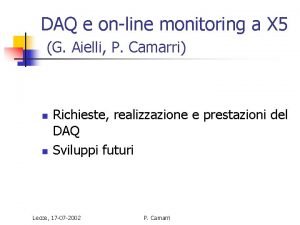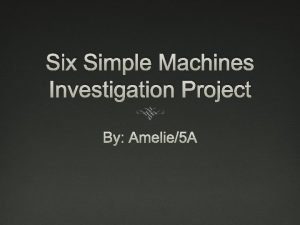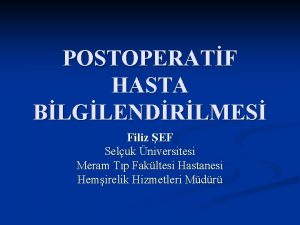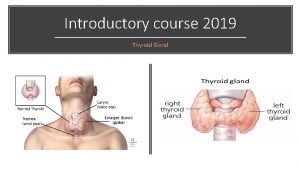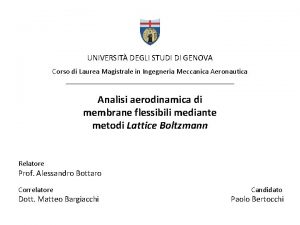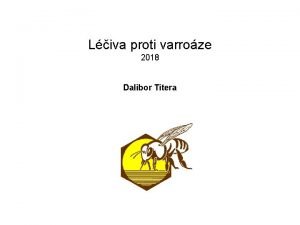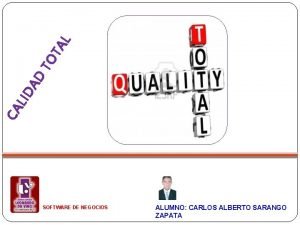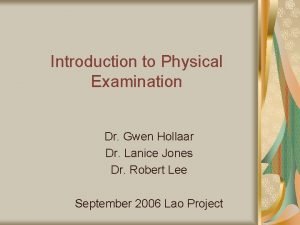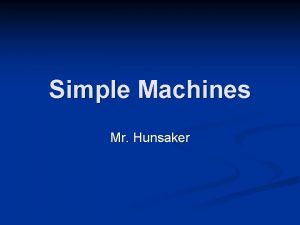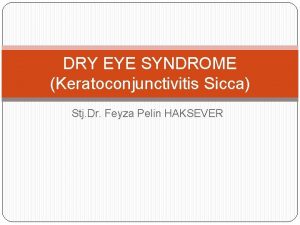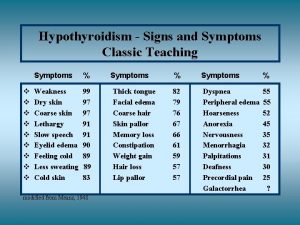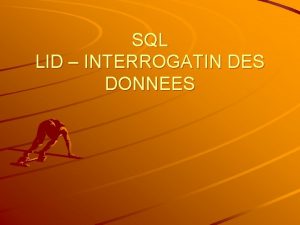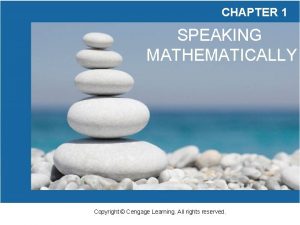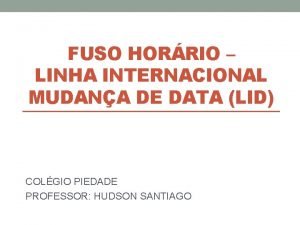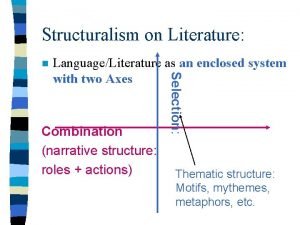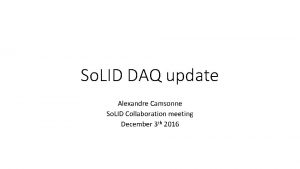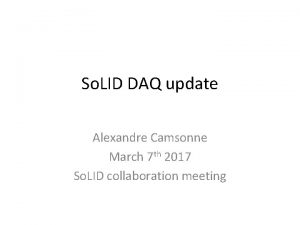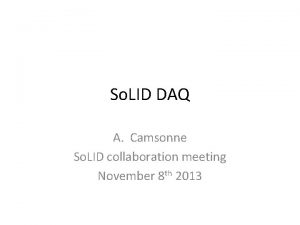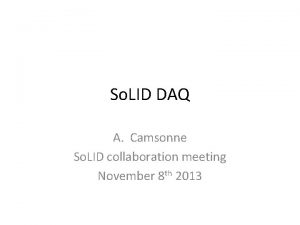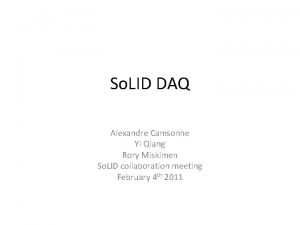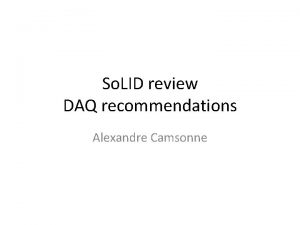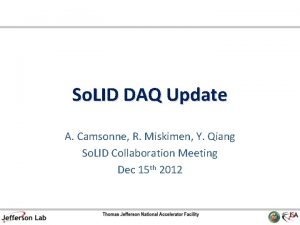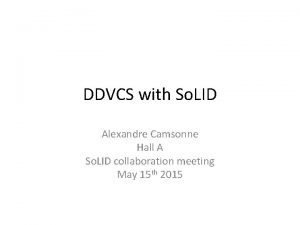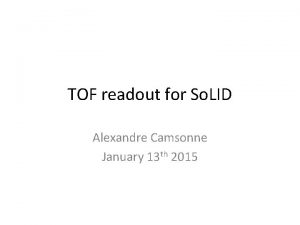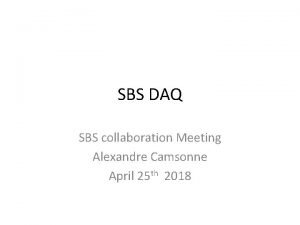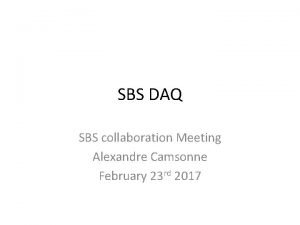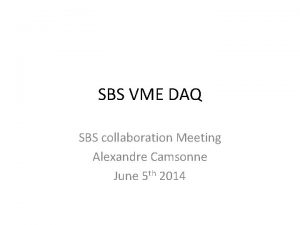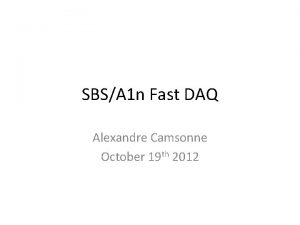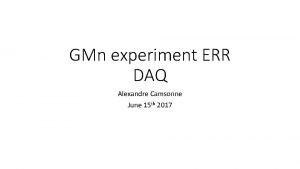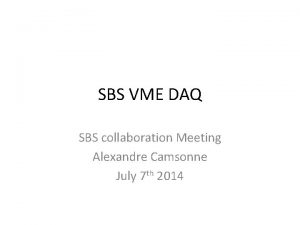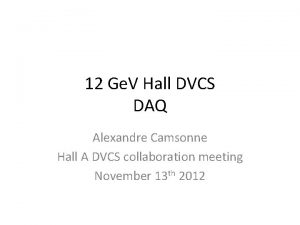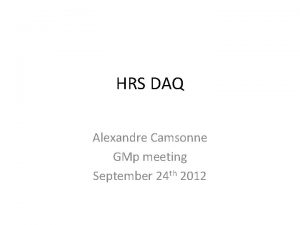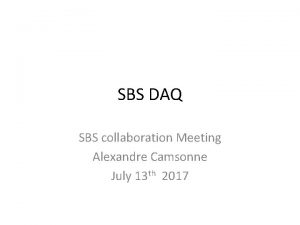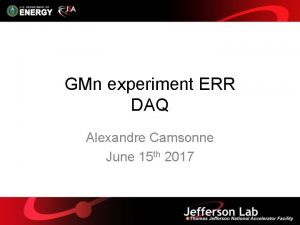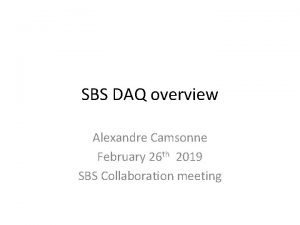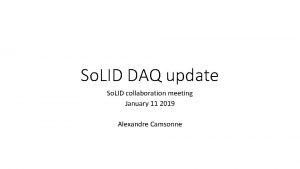So LID DAQ update Alexandre Camsonne August 27




































- Slides: 36

So. LID DAQ update Alexandre Camsonne August 27 th 2016 So. LID collaboration meeting

Overview • • • Recommendations for Director’s review Hardware available Document Updated trigger rates New FADC readout PVDIS deadtime SIDIS event size and data rates Cerenkov readout TOF readout options Simulations needs L 3 farm

Dead time correction PVDIS 1 b. 2 • Test with small scale setup ( ongoing ) • Simulation • Discuss with DAQ group for particular features needed – Example : helicity gated deadtimes • Rework CDR to add parity specific electronics • Need to write a separate document about DAQ requirements for DAQ group, Electronics group and potential collaborators on electronics (Saclay)

DAQ observations

Recommendations 2 c 1. a)The plans for the High Level Trigger and b) the needs for slow control (Brad) need to be worked out in detail and the implications for resources need to be evaluated. 2. The implications of the need for these resources in the context of availability of resources at the laboratory need to be understood. 3. Closer communication with the other JLab experiments and the JLab computing center is strongly encouraged. 4. Having a functional simulation and reconstruction routines as soon as possible should be a high priority in the software effort. Such software will pay off many times over in experimental design and avoiding pitfalls. ( Ole )

Hardware • • • FADC availables ( 4 + 18 = 22 all used) VXS (3 ) crates and Intel CPU ( 3 ) GTP borrowed , VTP received VETROC available (2 + 5 ordered ) R&D needed – Trigger setup ( pre. RD request ) – Deadtime measurement for PVDIS ( on going ) – ( High resolution TDC ) – VXS FADC readout ( ongoing DAQ funded )

DAQ document summary • Add parity specific requirements ? – – Deadtime Helicity BPM/charge measurement Pion trigger • Address comment : – L 3 farm performance and cost • • • Integrate new FADC fast readout TOF electronics options New GEM chip option Tape price Network upgrade • Give total price with dependencies and project price • Steve Wood summarizing pre. CDR and develop in contact with electronics and DAQ group

PVDIS electron trigger • Coincidence ECAL and Gas Cerenkov Old Hall D 290 KHz 230 KHz 1. 9 MHz 803 KHz 16. 5 KHz 4. 1 KHz DIS electron 10 KHz max 7. 7 KHz Total rate 27 KHz 12. 1 KHz Singles ECAL Singles rates Cerenkov Accidental 30 ns 7/9/2014 So. LID DAQ 8

Calorimeter FADC readout • New readout scheme through VTP – VME backplane 100 MB/s – VXS 16 x 500 MB/s • Can transfer a full ADC ( 16 channels * 20 samples =1. 3 KB) up to 390 KHz, transfer is not a bottle neck any more • GEM or SILO readout are limiting factor now

Deadtime measurement (1 b. 2) • Can deadtime affect PVDIS asymmetry ? • • Test stand Compton FADC Helicity gated scalers TI firmware modification Generate asymmetry same order of PVDIS Add random background Check asymmetry value Target date August

Dead time correction PVDIS 1 b. 2 • Test with small scale setup ( on going ) • Simulation • Discuss with DAQ group for particular features needed – Example : helicity gated deadtimes • Rework CDR to add parity specific electronics

Dead time correction PVDIS 1 b. 2

Dead time correction PVDIS 1 b. 2


FADC deadtime measurement Do we need to improve it ? Around 2 % deadtime R&D possible

Measured asymmetry

Deadtime measurement (1 b. 2) • FADC setup to study deadtime • Need to understand the system and model • Not done by August • Continue study with Compton during run

Cerenkov PMT readout • MAROC 3 close to what we need – 64 channels – Variable gain – Discriminated fast logic signal – Missing : analog sum of 8, need sum of 64 8 sum of 8 available just need to sum them, will check with INFN for modified RICH board, requested 10 K$ pre. RD money – Radiation hardness is pretty good, need to be tested, possibility of new version to handle Single Event Upset – MAROC default option – MAROC testboard available – • Will check design with electronics group for FADC analog output Possible readout schemes – – – FADC only ( default ) FADC + VETROC only : needs to be evaluated – Preferred : Add TDC readout for each Cerenkov channel 232 VETROC additionnal 700 K$, could improve Cerenkov trigger – – Need simulation to evaluate options Need to follow with electronics group to start testing ( anyone from Cernkov group interested ? )

TOF options • Expected timing resolution 80 to 50 ps • Default readout – NINO + TDC : 20 ps timing resolution • R&D MRPC : 20 ps – Sampling TDC ASICs : PSEC 4/5, SAMPIC, DRS 4 give 5 to 1 ps resolution – Need new chip DRS 5 or PSEC 5 to handle So. LID trigger rate ( analog pipeline ) ( might develop for EIC ) • Depends on final detector choice • Need to determine effect of photon background, might need sampling to deal with pile up

GEM readout • SRS deployed in Hall B Prad • MPD implemented in CODA – BLT testing few KHz – Optical fiber readout to be implemented for high rate test ( 100 MB/s to 1. 6 GB/s ) • Preliminary results from Weizhi : one sample no deconvolution not sufficient, new occupancy number • Data reduction on SSP for SBS • On chip deconvolution ( implemented in MPD ) still an option if needed • pre. RD to get VMM 3 chip

SIDIS event size Occupancies with one sample readout by Weizhi , rates for 100 KHz GEM Occupancy Number of strips XY strips Strips per chambers Event size ( Data rate 100 bytes ) KHz 1 2. 21 453 906 27180 2402. 712 240271200 240. 2712 2 8. 78 510 1020 30600 10746. 72 1074672000 1074. 672 3 3. 63 583 1166 34980 5079. 096 507909600 507. 9096 4 2. 31 702 1404 42120 3891. 888 389188800 389. 1888 5 1. 78 520 1040 31200 2221. 44 222144000 222. 144 6 1. 3 640 1280 38400 1996. 8 199680000 199. 68 Total 20. 01 3408 6816 204480 26338. 656 2633865600 2633. 8656 MB/s GEM dominating ( 35 bigger than initial proposal ) 2. 6 GB/s same requirement as PVDIS for L 3 Need to look at FADC occupancies

Pre RD hardware : detector test stand FADC 250 4500 4 18000 VETROC TD CTP SSP TID SD 4500 3000 7000 5000 3000 2500 2 1 1 1 9000 3000 7000 5000 3000 2500 FADC trigger Dist 4000 1 4000 VXS crate 15000 1 15000 VME CPU 4500 1 4500 Optical fiber 100 20 2000 Computer MPD 3000 4500 1 1 3000 4500 Network router 10000 1 10000 Total 72500 Added additionnal 10 K$ for MAROC and 15 K$ for VMM 3 : total 97 K$

Manpower • JLAB : – – – Alexandre Camsonne Robert Michaels ( Compton development ) Steve Wood Electronics group DAQ group • Stony Brook – – Seamus Riordan Krishna Kumar Postdoc Student • UVA : Danning Di GEM readout ( SBS / Tritium ) • University New Hampshire : Shujie Li ( part time ) • University of Columbia ( summer ) : Hanjie Lu Could use a full time student

L 3 farm (2 c 1) • Have digitized data for GEM for SIDIS and PVDIS • Weizhi has tracking algorithm take 2 to 10 ms to process one event so about 1000 nodes for 100 KHz • Need : – Other include detector data – Additionnal reduction algorithm – Implement tracking – Test on Hall D or DAQ cluster • Discussion with HPC/IT

L 3 trigger (2 c 1) • 2. 5 to 10 ms for tracking using Kalman Filter ( preliminary ) • PVDIS : 20 KHz 200 cores per sector 6000 cores total • SIDIS – 1000 cores for 100 KHz

L 3 trigger (2 c 1) • Discussed with HPC and IT – Network upgrade : • Current : 2 x 10 Gbit /s = 2 * 1. 2 GB/s from counting house to Computer center • Can be upgrade to 40 Gbit/s when cost go down ( ~5 years ) – Tape SILO TS 3500 • 16 drives : – 6 LTO 6 200 MB/sx 6 + LTO 7 300 MB/sx 8 = 3. 6 GB/s – LTO 7 300 MB/s x 16 -> 4. 8 GB/s – LTO 8 472 MB/sx 16 -> 7. 5 GB/s • Could add second library (150 K$ and each drive 28 K$ ) – L 3 could be located in CC and dynamically allocated ( free ! ) – Need to let IT know the requirements, could invest yearly, need about 2000 today cores

LTO timeline Bottomline : 3 GB/s is reasonable by 2020, L 3 farm optional

Tape costs (2 c 2) Days Data rate Seconds Total data Double DLO 5 in $ DLO 6 in $ DLO 7 in $ TB 2010 2012 2015 DLO 8 in $ 2020? E 12 -11 -108 Pol proton 120 250 10368000 2592 5184 259200 155520 62208 30375 E 12 -12 -006 J/Psi 60 250 5184000 1296 2592 129600 77760 31104 15187. 5 E 12 -10 -006 Transv. Pol. 3 He 90 250 7776000 1944 3888 194400 116640 46656 22781. 25 E 12 -11 -007 Long. Pol. 3 He 35 250 3024000 756 1512 75600 45360 18144 8859. 375 E 12 -10 -007 PVDIS 169 250 14601600 3650. 4 7300. 8 365040 219024 87609. 6 42778. 125 Total 474 40953600 10238. 4 20476. 8 1023840 614304 245721. 6 119981. 25 Per year 394200 236520 94608 46195. 3125 Actual days Actual years 948 2. 60 Time in s 474 40953600 About 17 K$ per PB, 11 K$ per PB for tapes about 250 K$ for 20 PB Cynthia would like about 70 K$ per year in tape ( 50 K$ per year at 250 MB/s), but 300 K$ is not unreasonable if planned in advance Numbers don’t include compression ( additionnal factor of 2 ) Expected to go down by a factor 5 by 2020

Beam test • 11 Ge. V beam available – Test detectors : • • GEM Calorimeter MRPC Cerenkov – Background measurements • Some hardware available : – FADCs, MAROC • Starting paperwork : getting ready for Calorimeter, GEM, LGC test

Hardware • Trigger test HCAL : 16 FADC + GTP – Trigger test completion in about 2 months • GEM : – 5 MPDs – First iteration of CODA library – Implementation optical link readout ( 2 months ) – SRS : successfully used up to 5 KHz

Available in October • SBS projects ( DOE review November ) – GTP/VTP calorimeter trigger test – GEM : preliminary performance • PVDIS deadtime systematic using Compton test stand, implement simulation if enough time • L 3 : most likely possible and not needed

Simulations needs • GEM occupancies and digitization SIDIS for event size, occupancy and tracking (Ole, Zhiwen, Weizhi Duke ) • Updated trigger rates PVDIS, SIDIS(Zhiwen, Rakitah) • FADC digitization PVDIS : realistic PID (? ) • Cerenkov simulation only timing readout no FADC(? ) • Effect 1 sample vs 3 samples GEM (Weizhi ) and 20 samples vs time integral SIDIS (? ) • Full FADC trigger simulation • MRPC simulation : response to background

Communication with other groups 2 c 3 • Try collaborate with Hall D • Constant communication with JLAB DAQ and electronics group • Hall C, SBS interested in using VETROC for logic and readout • check experience with APV and FADC from HPS and PRAD – Already planning to reuse HPS trigger scheme

Forgotten recommendation • Bunker design – Radiation – Cooling of bunker to be evaluated / design

Recommendations 2 c 1. a)The plans for the High Level Trigger and b) the needs for slow control (see Brad’s talk) need to be worked out in detail and the implications for resources need to be evaluated. 2. The implications of the need for these resources in the context of availability of resources at the laboratory need to be understood. 3. Closer communication with the other JLab experiments and the JLab computing center is strongly encouraged. 4. Having a functional simulation and reconstruction routines as soon as possible should be a high priority in the software effort. Such software will pay off many times over in experimental design and avoiding pitfalls. ( Ole’s talk )

Conclusion • New results from Simulation – PVDIS rate lower 12 KHz, not an issue – SIDIS : • 1 sample GEM readout seems to work and with occupancies similar to PVDIS data rate • Up to 3 GB/s most likely can be handled by SILO, L 3 most likely not required and could be available mostly for free – To do : • TOF background • Need to check J/Psi and TCS occupancies, rates and efficiencies • • • MAROC default option for Cerenkov readout TOF : PSEC 5 preferred option, need simulation PVDIS deadtime : hardware setup, ongoing study Test run in beam Start work on document update
 Which is an alternative of log based recovery
Which is an alternative of log based recovery Adc simultaneous sampling
Adc simultaneous sampling Digital data acquisition system block diagram
Digital data acquisition system block diagram Clark county daq
Clark county daq Mini daq
Mini daq Daq swim
Daq swim Bls game
Bls game Vme
Vme Inclined plane wrapped around a pole
Inclined plane wrapped around a pole Lid care solüsyon
Lid care solüsyon Large rectangular pan, often with a lid and a meat rack.
Large rectangular pan, often with a lid and a meat rack. Flip your lid
Flip your lid Lid retraction
Lid retraction Trojí lid
Trojí lid Equazione di boltzmann
Equazione di boltzmann Beegym
Beegym Lid lag
Lid lag Ad lid
Ad lid Lid hygenix
Lid hygenix Tin lid aussie slang
Tin lid aussie slang Lid lag
Lid lag Cosi simple machines
Cosi simple machines Lid globe congruity
Lid globe congruity What is lid lag
What is lid lag Classification of simple machine
Classification of simple machine Sql lid
Sql lid Lid lag
Lid lag Why data quality matters
Why data quality matters What is wedge
What is wedge Existential universal statements examples
Existential universal statements examples Flip your lid
Flip your lid Linha de mudança de data
Linha de mudança de data Narrative structure examples
Narrative structure examples Rewriting universal conditional statement
Rewriting universal conditional statement Alexandre dubosc
Alexandre dubosc Tipos de estudo epidemiologico
Tipos de estudo epidemiologico Alexandre rotenberg
Alexandre rotenberg

